Contemporary Accounting Theory: IFRS, Regulatory Capture in UK/Aus
VerifiedAdded on 2023/06/13
|12
|3935
|207
Report
AI Summary
This report provides a comprehensive literature review of the regulatory requirements in the UK and Australia, focusing on the adoption of International Financial Reporting Standards (IFRS). It examines the regulatory environment, the involvement of major decision-makers, and relevant legislations. The report highlights the progress of both countries in adopting IFRS, the challenges faced during implementation (such as lack of training in Australia and delays in the UK), and the role of bodies like the European Financial Reporting Advisory Group (EFRAG). Furthermore, it explores the Regulatory Capture Theory, discussing how special interest groups can influence regulatory agencies, and identifies characteristics indicating potential regulatory capture. The report concludes by differentiating between IFRS and UK and Ireland GAAP, emphasizing the complexities of financial reporting frameworks in these regions. Desklib offers a wealth of similar solved assignments and past papers to aid students in their studies.
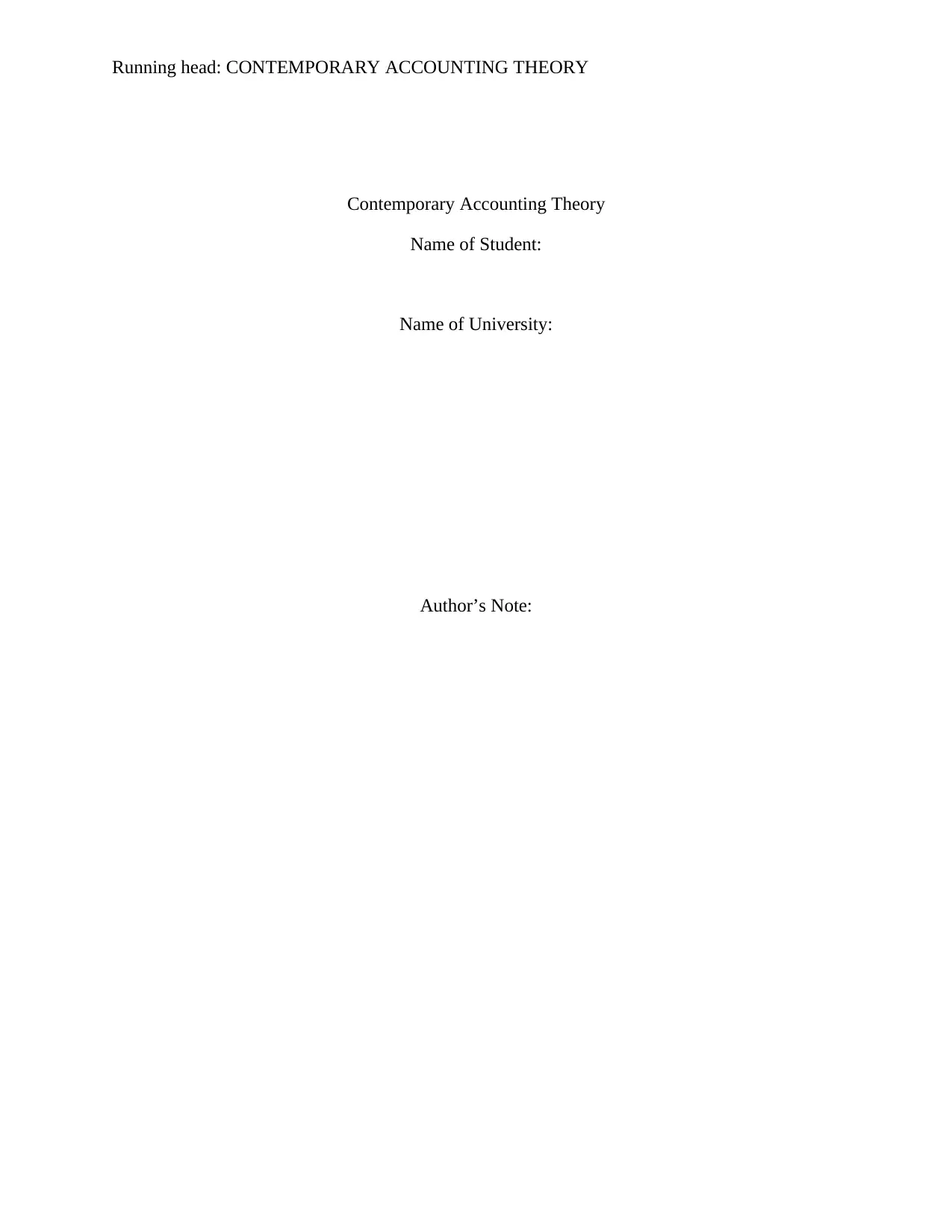
Running head: CONTEMPORARY ACCOUNTING THEORY
Contemporary Accounting Theory
Name of Student:
Name of University:
Author’s Note:
Contemporary Accounting Theory
Name of Student:
Name of University:
Author’s Note:
Paraphrase This Document
Need a fresh take? Get an instant paraphrase of this document with our AI Paraphraser
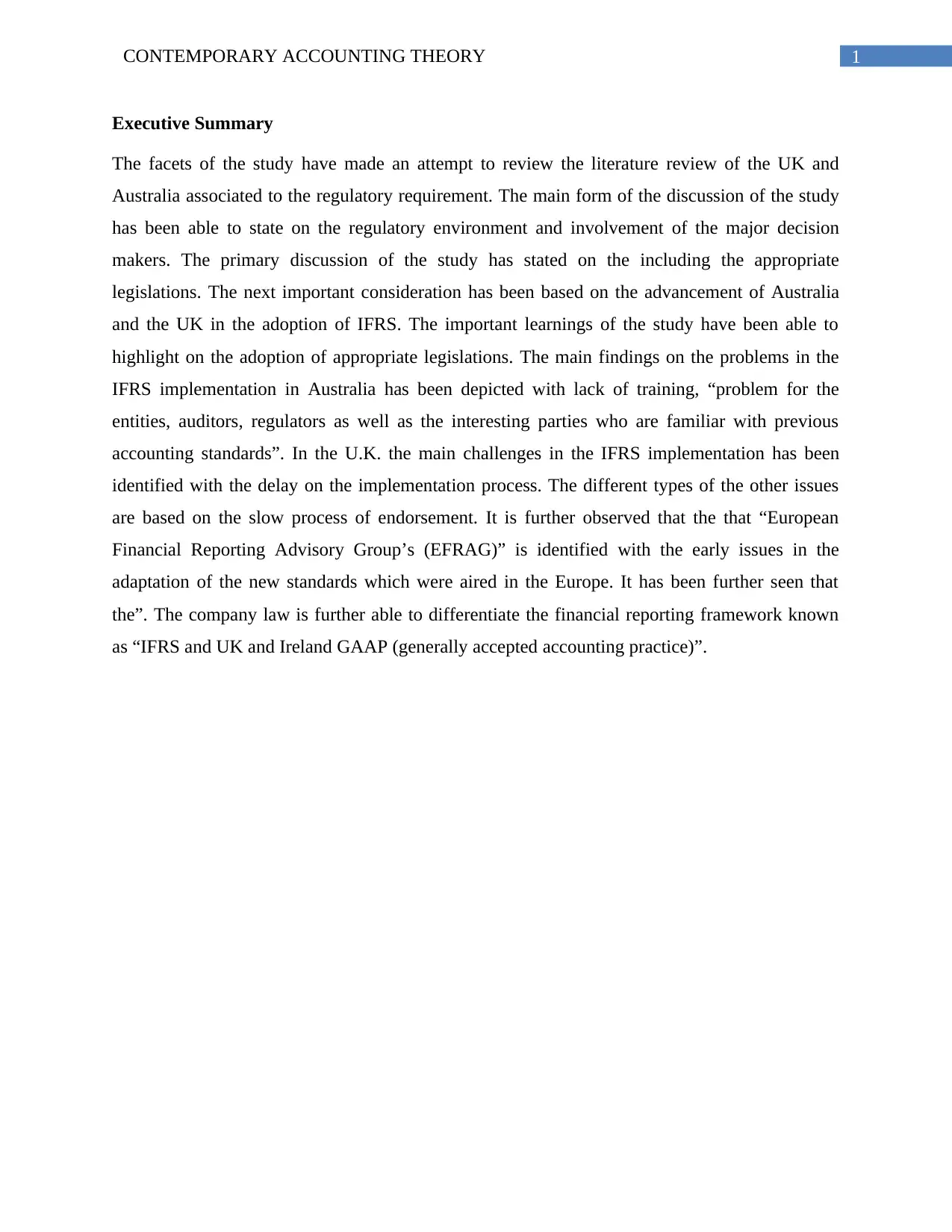
1CONTEMPORARY ACCOUNTING THEORY
Executive Summary
The facets of the study have made an attempt to review the literature review of the UK and
Australia associated to the regulatory requirement. The main form of the discussion of the study
has been able to state on the regulatory environment and involvement of the major decision
makers. The primary discussion of the study has stated on the including the appropriate
legislations. The next important consideration has been based on the advancement of Australia
and the UK in the adoption of IFRS. The important learnings of the study have been able to
highlight on the adoption of appropriate legislations. The main findings on the problems in the
IFRS implementation in Australia has been depicted with lack of training, “problem for the
entities, auditors, regulators as well as the interesting parties who are familiar with previous
accounting standards”. In the U.K. the main challenges in the IFRS implementation has been
identified with the delay on the implementation process. The different types of the other issues
are based on the slow process of endorsement. It is further observed that the that “European
Financial Reporting Advisory Group’s (EFRAG)” is identified with the early issues in the
adaptation of the new standards which were aired in the Europe. It has been further seen that
the”. The company law is further able to differentiate the financial reporting framework known
as “IFRS and UK and Ireland GAAP (generally accepted accounting practice)”.
Executive Summary
The facets of the study have made an attempt to review the literature review of the UK and
Australia associated to the regulatory requirement. The main form of the discussion of the study
has been able to state on the regulatory environment and involvement of the major decision
makers. The primary discussion of the study has stated on the including the appropriate
legislations. The next important consideration has been based on the advancement of Australia
and the UK in the adoption of IFRS. The important learnings of the study have been able to
highlight on the adoption of appropriate legislations. The main findings on the problems in the
IFRS implementation in Australia has been depicted with lack of training, “problem for the
entities, auditors, regulators as well as the interesting parties who are familiar with previous
accounting standards”. In the U.K. the main challenges in the IFRS implementation has been
identified with the delay on the implementation process. The different types of the other issues
are based on the slow process of endorsement. It is further observed that the that “European
Financial Reporting Advisory Group’s (EFRAG)” is identified with the early issues in the
adaptation of the new standards which were aired in the Europe. It has been further seen that
the”. The company law is further able to differentiate the financial reporting framework known
as “IFRS and UK and Ireland GAAP (generally accepted accounting practice)”.
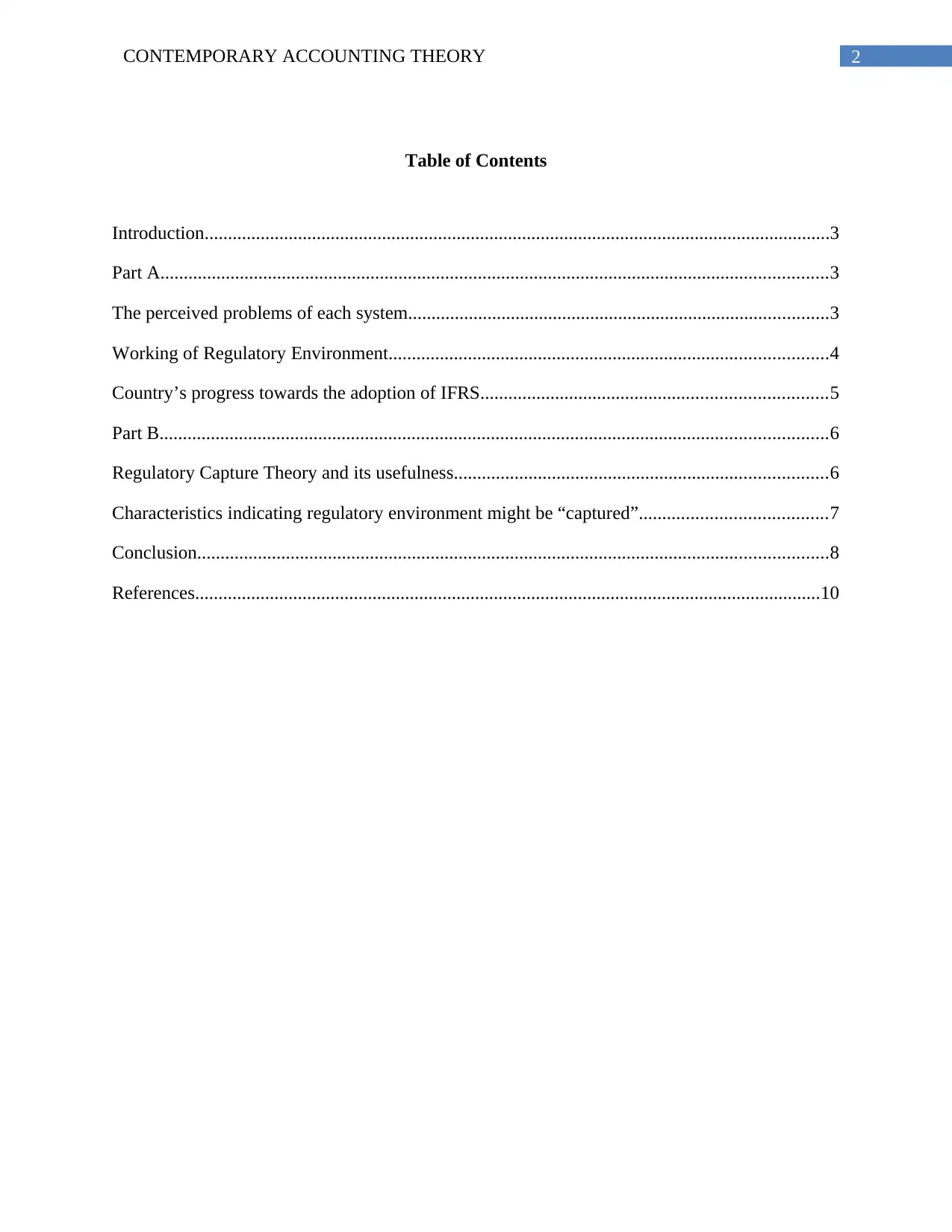
2CONTEMPORARY ACCOUNTING THEORY
Table of Contents
Introduction......................................................................................................................................3
Part A...............................................................................................................................................3
The perceived problems of each system..........................................................................................3
Working of Regulatory Environment..............................................................................................4
Country’s progress towards the adoption of IFRS..........................................................................5
Part B...............................................................................................................................................6
Regulatory Capture Theory and its usefulness................................................................................6
Characteristics indicating regulatory environment might be “captured”........................................7
Conclusion.......................................................................................................................................8
References......................................................................................................................................10
Table of Contents
Introduction......................................................................................................................................3
Part A...............................................................................................................................................3
The perceived problems of each system..........................................................................................3
Working of Regulatory Environment..............................................................................................4
Country’s progress towards the adoption of IFRS..........................................................................5
Part B...............................................................................................................................................6
Regulatory Capture Theory and its usefulness................................................................................6
Characteristics indicating regulatory environment might be “captured”........................................7
Conclusion.......................................................................................................................................8
References......................................................................................................................................10
⊘ This is a preview!⊘
Do you want full access?
Subscribe today to unlock all pages.

Trusted by 1+ million students worldwide
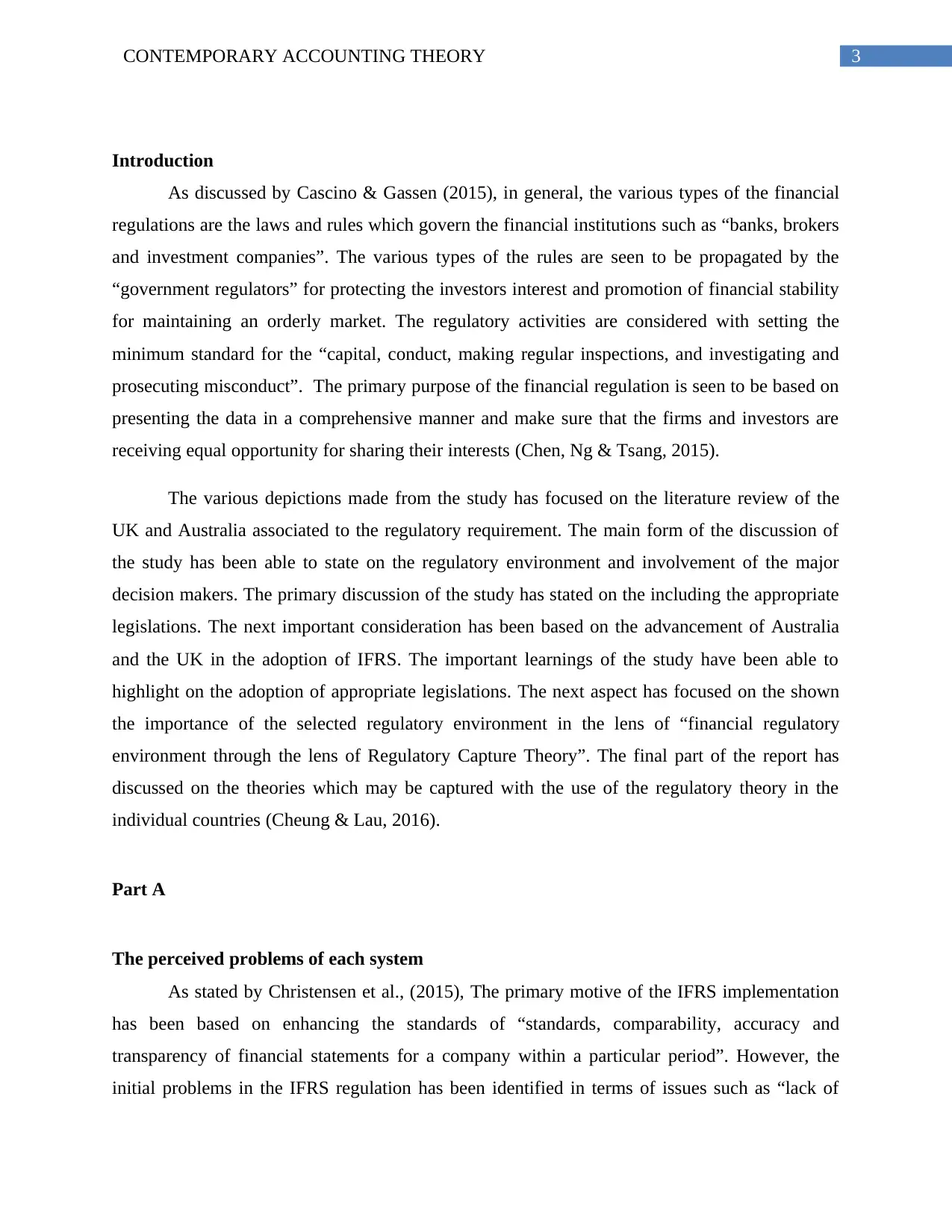
3CONTEMPORARY ACCOUNTING THEORY
Introduction
As discussed by Cascino & Gassen (2015), in general, the various types of the financial
regulations are the laws and rules which govern the financial institutions such as “banks, brokers
and investment companies”. The various types of the rules are seen to be propagated by the
“government regulators” for protecting the investors interest and promotion of financial stability
for maintaining an orderly market. The regulatory activities are considered with setting the
minimum standard for the “capital, conduct, making regular inspections, and investigating and
prosecuting misconduct”. The primary purpose of the financial regulation is seen to be based on
presenting the data in a comprehensive manner and make sure that the firms and investors are
receiving equal opportunity for sharing their interests (Chen, Ng & Tsang, 2015).
The various depictions made from the study has focused on the literature review of the
UK and Australia associated to the regulatory requirement. The main form of the discussion of
the study has been able to state on the regulatory environment and involvement of the major
decision makers. The primary discussion of the study has stated on the including the appropriate
legislations. The next important consideration has been based on the advancement of Australia
and the UK in the adoption of IFRS. The important learnings of the study have been able to
highlight on the adoption of appropriate legislations. The next aspect has focused on the shown
the importance of the selected regulatory environment in the lens of “financial regulatory
environment through the lens of Regulatory Capture Theory”. The final part of the report has
discussed on the theories which may be captured with the use of the regulatory theory in the
individual countries (Cheung & Lau, 2016).
Part A
The perceived problems of each system
As stated by Christensen et al., (2015), The primary motive of the IFRS implementation
has been based on enhancing the standards of “standards, comparability, accuracy and
transparency of financial statements for a company within a particular period”. However, the
initial problems in the IFRS regulation has been identified in terms of issues such as “lack of
Introduction
As discussed by Cascino & Gassen (2015), in general, the various types of the financial
regulations are the laws and rules which govern the financial institutions such as “banks, brokers
and investment companies”. The various types of the rules are seen to be propagated by the
“government regulators” for protecting the investors interest and promotion of financial stability
for maintaining an orderly market. The regulatory activities are considered with setting the
minimum standard for the “capital, conduct, making regular inspections, and investigating and
prosecuting misconduct”. The primary purpose of the financial regulation is seen to be based on
presenting the data in a comprehensive manner and make sure that the firms and investors are
receiving equal opportunity for sharing their interests (Chen, Ng & Tsang, 2015).
The various depictions made from the study has focused on the literature review of the
UK and Australia associated to the regulatory requirement. The main form of the discussion of
the study has been able to state on the regulatory environment and involvement of the major
decision makers. The primary discussion of the study has stated on the including the appropriate
legislations. The next important consideration has been based on the advancement of Australia
and the UK in the adoption of IFRS. The important learnings of the study have been able to
highlight on the adoption of appropriate legislations. The next aspect has focused on the shown
the importance of the selected regulatory environment in the lens of “financial regulatory
environment through the lens of Regulatory Capture Theory”. The final part of the report has
discussed on the theories which may be captured with the use of the regulatory theory in the
individual countries (Cheung & Lau, 2016).
Part A
The perceived problems of each system
As stated by Christensen et al., (2015), The primary motive of the IFRS implementation
has been based on enhancing the standards of “standards, comparability, accuracy and
transparency of financial statements for a company within a particular period”. However, the
initial problems in the IFRS regulation has been identified in terms of issues such as “lack of
Paraphrase This Document
Need a fresh take? Get an instant paraphrase of this document with our AI Paraphraser
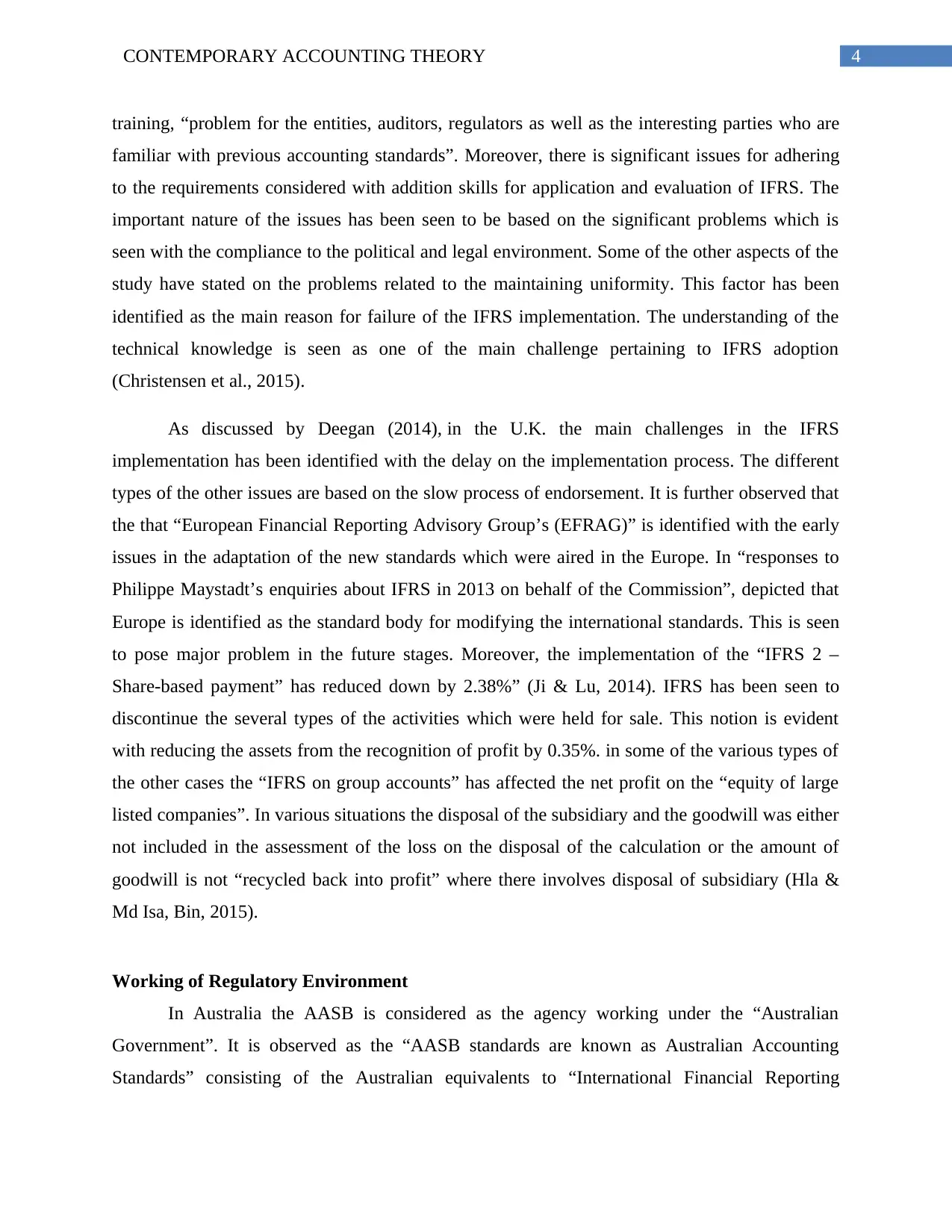
4CONTEMPORARY ACCOUNTING THEORY
training, “problem for the entities, auditors, regulators as well as the interesting parties who are
familiar with previous accounting standards”. Moreover, there is significant issues for adhering
to the requirements considered with addition skills for application and evaluation of IFRS. The
important nature of the issues has been seen to be based on the significant problems which is
seen with the compliance to the political and legal environment. Some of the other aspects of the
study have stated on the problems related to the maintaining uniformity. This factor has been
identified as the main reason for failure of the IFRS implementation. The understanding of the
technical knowledge is seen as one of the main challenge pertaining to IFRS adoption
(Christensen et al., 2015).
As discussed by Deegan (2014), in the U.K. the main challenges in the IFRS
implementation has been identified with the delay on the implementation process. The different
types of the other issues are based on the slow process of endorsement. It is further observed that
the that “European Financial Reporting Advisory Group’s (EFRAG)” is identified with the early
issues in the adaptation of the new standards which were aired in the Europe. In “responses to
Philippe Maystadt’s enquiries about IFRS in 2013 on behalf of the Commission”, depicted that
Europe is identified as the standard body for modifying the international standards. This is seen
to pose major problem in the future stages. Moreover, the implementation of the “IFRS 2 –
Share-based payment” has reduced down by 2.38%” (Ji & Lu, 2014). IFRS has been seen to
discontinue the several types of the activities which were held for sale. This notion is evident
with reducing the assets from the recognition of profit by 0.35%. in some of the various types of
the other cases the “IFRS on group accounts” has affected the net profit on the “equity of large
listed companies”. In various situations the disposal of the subsidiary and the goodwill was either
not included in the assessment of the loss on the disposal of the calculation or the amount of
goodwill is not “recycled back into profit” where there involves disposal of subsidiary (Hla &
Md Isa, Bin, 2015).
Working of Regulatory Environment
In Australia the AASB is considered as the agency working under the “Australian
Government”. It is observed as the “AASB standards are known as Australian Accounting
Standards” consisting of the Australian equivalents to “International Financial Reporting
training, “problem for the entities, auditors, regulators as well as the interesting parties who are
familiar with previous accounting standards”. Moreover, there is significant issues for adhering
to the requirements considered with addition skills for application and evaluation of IFRS. The
important nature of the issues has been seen to be based on the significant problems which is
seen with the compliance to the political and legal environment. Some of the other aspects of the
study have stated on the problems related to the maintaining uniformity. This factor has been
identified as the main reason for failure of the IFRS implementation. The understanding of the
technical knowledge is seen as one of the main challenge pertaining to IFRS adoption
(Christensen et al., 2015).
As discussed by Deegan (2014), in the U.K. the main challenges in the IFRS
implementation has been identified with the delay on the implementation process. The different
types of the other issues are based on the slow process of endorsement. It is further observed that
the that “European Financial Reporting Advisory Group’s (EFRAG)” is identified with the early
issues in the adaptation of the new standards which were aired in the Europe. In “responses to
Philippe Maystadt’s enquiries about IFRS in 2013 on behalf of the Commission”, depicted that
Europe is identified as the standard body for modifying the international standards. This is seen
to pose major problem in the future stages. Moreover, the implementation of the “IFRS 2 –
Share-based payment” has reduced down by 2.38%” (Ji & Lu, 2014). IFRS has been seen to
discontinue the several types of the activities which were held for sale. This notion is evident
with reducing the assets from the recognition of profit by 0.35%. in some of the various types of
the other cases the “IFRS on group accounts” has affected the net profit on the “equity of large
listed companies”. In various situations the disposal of the subsidiary and the goodwill was either
not included in the assessment of the loss on the disposal of the calculation or the amount of
goodwill is not “recycled back into profit” where there involves disposal of subsidiary (Hla &
Md Isa, Bin, 2015).
Working of Regulatory Environment
In Australia the AASB is considered as the agency working under the “Australian
Government”. It is observed as the “AASB standards are known as Australian Accounting
Standards” consisting of the Australian equivalents to “International Financial Reporting
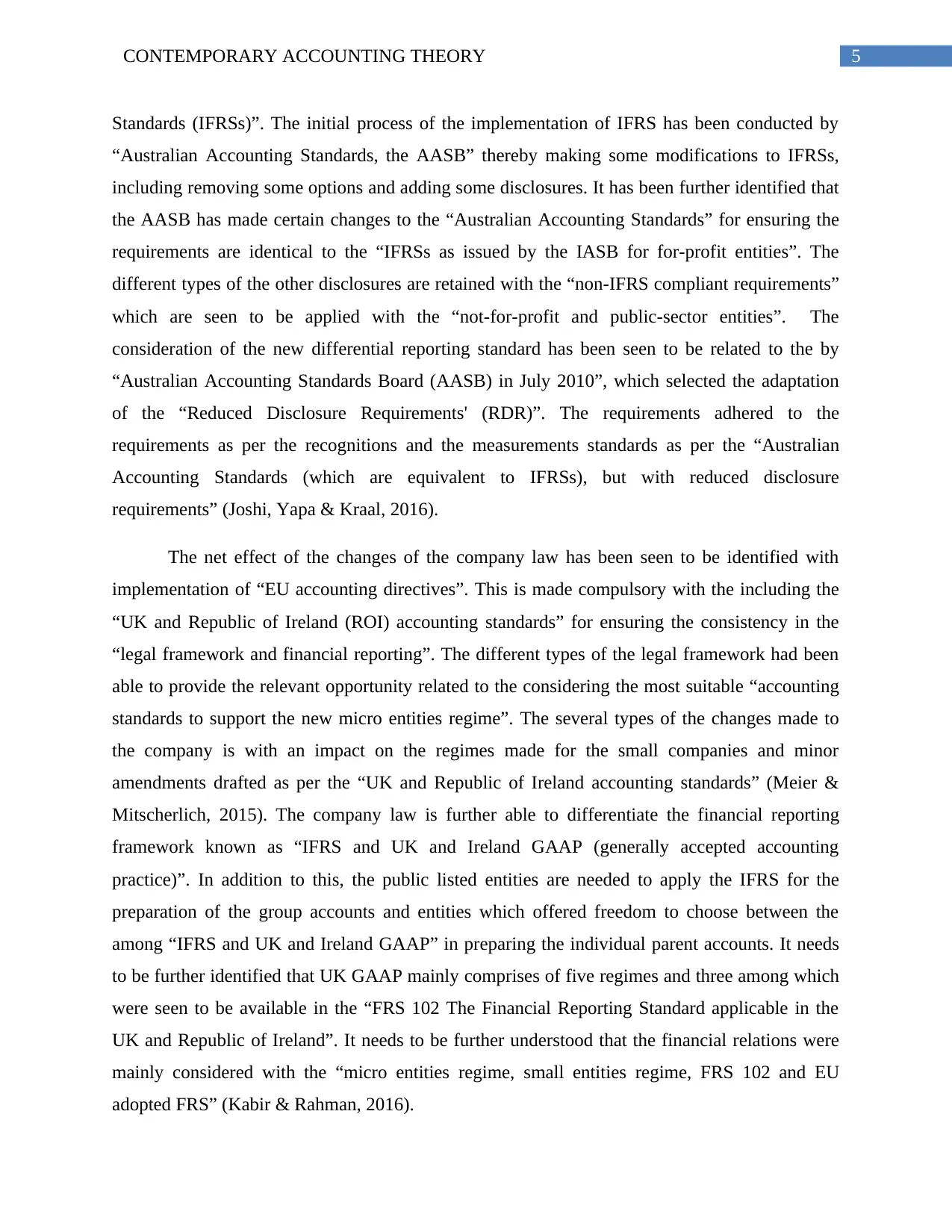
5CONTEMPORARY ACCOUNTING THEORY
Standards (IFRSs)”. The initial process of the implementation of IFRS has been conducted by
“Australian Accounting Standards, the AASB” thereby making some modifications to IFRSs,
including removing some options and adding some disclosures. It has been further identified that
the AASB has made certain changes to the “Australian Accounting Standards” for ensuring the
requirements are identical to the “IFRSs as issued by the IASB for for-profit entities”. The
different types of the other disclosures are retained with the “non-IFRS compliant requirements”
which are seen to be applied with the “not-for-profit and public-sector entities”. The
consideration of the new differential reporting standard has been seen to be related to the by
“Australian Accounting Standards Board (AASB) in July 2010”, which selected the adaptation
of the “Reduced Disclosure Requirements' (RDR)”. The requirements adhered to the
requirements as per the recognitions and the measurements standards as per the “Australian
Accounting Standards (which are equivalent to IFRSs), but with reduced disclosure
requirements” (Joshi, Yapa & Kraal, 2016).
The net effect of the changes of the company law has been seen to be identified with
implementation of “EU accounting directives”. This is made compulsory with the including the
“UK and Republic of Ireland (ROI) accounting standards” for ensuring the consistency in the
“legal framework and financial reporting”. The different types of the legal framework had been
able to provide the relevant opportunity related to the considering the most suitable “accounting
standards to support the new micro entities regime”. The several types of the changes made to
the company is with an impact on the regimes made for the small companies and minor
amendments drafted as per the “UK and Republic of Ireland accounting standards” (Meier &
Mitscherlich, 2015). The company law is further able to differentiate the financial reporting
framework known as “IFRS and UK and Ireland GAAP (generally accepted accounting
practice)”. In addition to this, the public listed entities are needed to apply the IFRS for the
preparation of the group accounts and entities which offered freedom to choose between the
among “IFRS and UK and Ireland GAAP” in preparing the individual parent accounts. It needs
to be further identified that UK GAAP mainly comprises of five regimes and three among which
were seen to be available in the “FRS 102 The Financial Reporting Standard applicable in the
UK and Republic of Ireland”. It needs to be further understood that the financial relations were
mainly considered with the “micro entities regime, small entities regime, FRS 102 and EU
adopted FRS” (Kabir & Rahman, 2016).
Standards (IFRSs)”. The initial process of the implementation of IFRS has been conducted by
“Australian Accounting Standards, the AASB” thereby making some modifications to IFRSs,
including removing some options and adding some disclosures. It has been further identified that
the AASB has made certain changes to the “Australian Accounting Standards” for ensuring the
requirements are identical to the “IFRSs as issued by the IASB for for-profit entities”. The
different types of the other disclosures are retained with the “non-IFRS compliant requirements”
which are seen to be applied with the “not-for-profit and public-sector entities”. The
consideration of the new differential reporting standard has been seen to be related to the by
“Australian Accounting Standards Board (AASB) in July 2010”, which selected the adaptation
of the “Reduced Disclosure Requirements' (RDR)”. The requirements adhered to the
requirements as per the recognitions and the measurements standards as per the “Australian
Accounting Standards (which are equivalent to IFRSs), but with reduced disclosure
requirements” (Joshi, Yapa & Kraal, 2016).
The net effect of the changes of the company law has been seen to be identified with
implementation of “EU accounting directives”. This is made compulsory with the including the
“UK and Republic of Ireland (ROI) accounting standards” for ensuring the consistency in the
“legal framework and financial reporting”. The different types of the legal framework had been
able to provide the relevant opportunity related to the considering the most suitable “accounting
standards to support the new micro entities regime”. The several types of the changes made to
the company is with an impact on the regimes made for the small companies and minor
amendments drafted as per the “UK and Republic of Ireland accounting standards” (Meier &
Mitscherlich, 2015). The company law is further able to differentiate the financial reporting
framework known as “IFRS and UK and Ireland GAAP (generally accepted accounting
practice)”. In addition to this, the public listed entities are needed to apply the IFRS for the
preparation of the group accounts and entities which offered freedom to choose between the
among “IFRS and UK and Ireland GAAP” in preparing the individual parent accounts. It needs
to be further identified that UK GAAP mainly comprises of five regimes and three among which
were seen to be available in the “FRS 102 The Financial Reporting Standard applicable in the
UK and Republic of Ireland”. It needs to be further understood that the financial relations were
mainly considered with the “micro entities regime, small entities regime, FRS 102 and EU
adopted FRS” (Kabir & Rahman, 2016).
⊘ This is a preview!⊘
Do you want full access?
Subscribe today to unlock all pages.

Trusted by 1+ million students worldwide
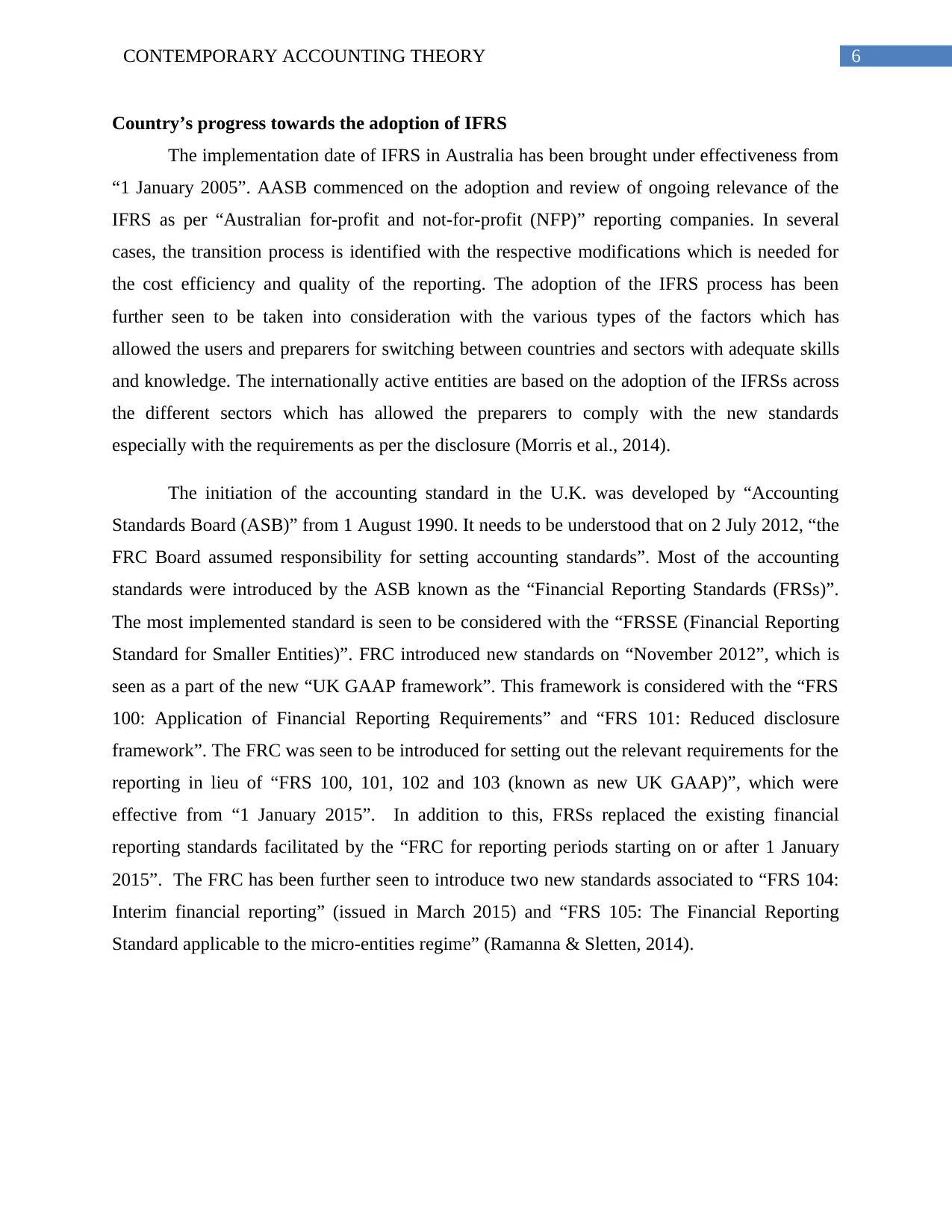
6CONTEMPORARY ACCOUNTING THEORY
Country’s progress towards the adoption of IFRS
The implementation date of IFRS in Australia has been brought under effectiveness from
“1 January 2005”. AASB commenced on the adoption and review of ongoing relevance of the
IFRS as per “Australian for-profit and not-for-profit (NFP)” reporting companies. In several
cases, the transition process is identified with the respective modifications which is needed for
the cost efficiency and quality of the reporting. The adoption of the IFRS process has been
further seen to be taken into consideration with the various types of the factors which has
allowed the users and preparers for switching between countries and sectors with adequate skills
and knowledge. The internationally active entities are based on the adoption of the IFRSs across
the different sectors which has allowed the preparers to comply with the new standards
especially with the requirements as per the disclosure (Morris et al., 2014).
The initiation of the accounting standard in the U.K. was developed by “Accounting
Standards Board (ASB)” from 1 August 1990. It needs to be understood that on 2 July 2012, “the
FRC Board assumed responsibility for setting accounting standards”. Most of the accounting
standards were introduced by the ASB known as the “Financial Reporting Standards (FRSs)”.
The most implemented standard is seen to be considered with the “FRSSE (Financial Reporting
Standard for Smaller Entities)”. FRC introduced new standards on “November 2012”, which is
seen as a part of the new “UK GAAP framework”. This framework is considered with the “FRS
100: Application of Financial Reporting Requirements” and “FRS 101: Reduced disclosure
framework”. The FRC was seen to be introduced for setting out the relevant requirements for the
reporting in lieu of “FRS 100, 101, 102 and 103 (known as new UK GAAP)”, which were
effective from “1 January 2015”. In addition to this, FRSs replaced the existing financial
reporting standards facilitated by the “FRC for reporting periods starting on or after 1 January
2015”. The FRC has been further seen to introduce two new standards associated to “FRS 104:
Interim financial reporting” (issued in March 2015) and “FRS 105: The Financial Reporting
Standard applicable to the micro-entities regime” (Ramanna & Sletten, 2014).
Country’s progress towards the adoption of IFRS
The implementation date of IFRS in Australia has been brought under effectiveness from
“1 January 2005”. AASB commenced on the adoption and review of ongoing relevance of the
IFRS as per “Australian for-profit and not-for-profit (NFP)” reporting companies. In several
cases, the transition process is identified with the respective modifications which is needed for
the cost efficiency and quality of the reporting. The adoption of the IFRS process has been
further seen to be taken into consideration with the various types of the factors which has
allowed the users and preparers for switching between countries and sectors with adequate skills
and knowledge. The internationally active entities are based on the adoption of the IFRSs across
the different sectors which has allowed the preparers to comply with the new standards
especially with the requirements as per the disclosure (Morris et al., 2014).
The initiation of the accounting standard in the U.K. was developed by “Accounting
Standards Board (ASB)” from 1 August 1990. It needs to be understood that on 2 July 2012, “the
FRC Board assumed responsibility for setting accounting standards”. Most of the accounting
standards were introduced by the ASB known as the “Financial Reporting Standards (FRSs)”.
The most implemented standard is seen to be considered with the “FRSSE (Financial Reporting
Standard for Smaller Entities)”. FRC introduced new standards on “November 2012”, which is
seen as a part of the new “UK GAAP framework”. This framework is considered with the “FRS
100: Application of Financial Reporting Requirements” and “FRS 101: Reduced disclosure
framework”. The FRC was seen to be introduced for setting out the relevant requirements for the
reporting in lieu of “FRS 100, 101, 102 and 103 (known as new UK GAAP)”, which were
effective from “1 January 2015”. In addition to this, FRSs replaced the existing financial
reporting standards facilitated by the “FRC for reporting periods starting on or after 1 January
2015”. The FRC has been further seen to introduce two new standards associated to “FRS 104:
Interim financial reporting” (issued in March 2015) and “FRS 105: The Financial Reporting
Standard applicable to the micro-entities regime” (Ramanna & Sletten, 2014).
Paraphrase This Document
Need a fresh take? Get an instant paraphrase of this document with our AI Paraphraser
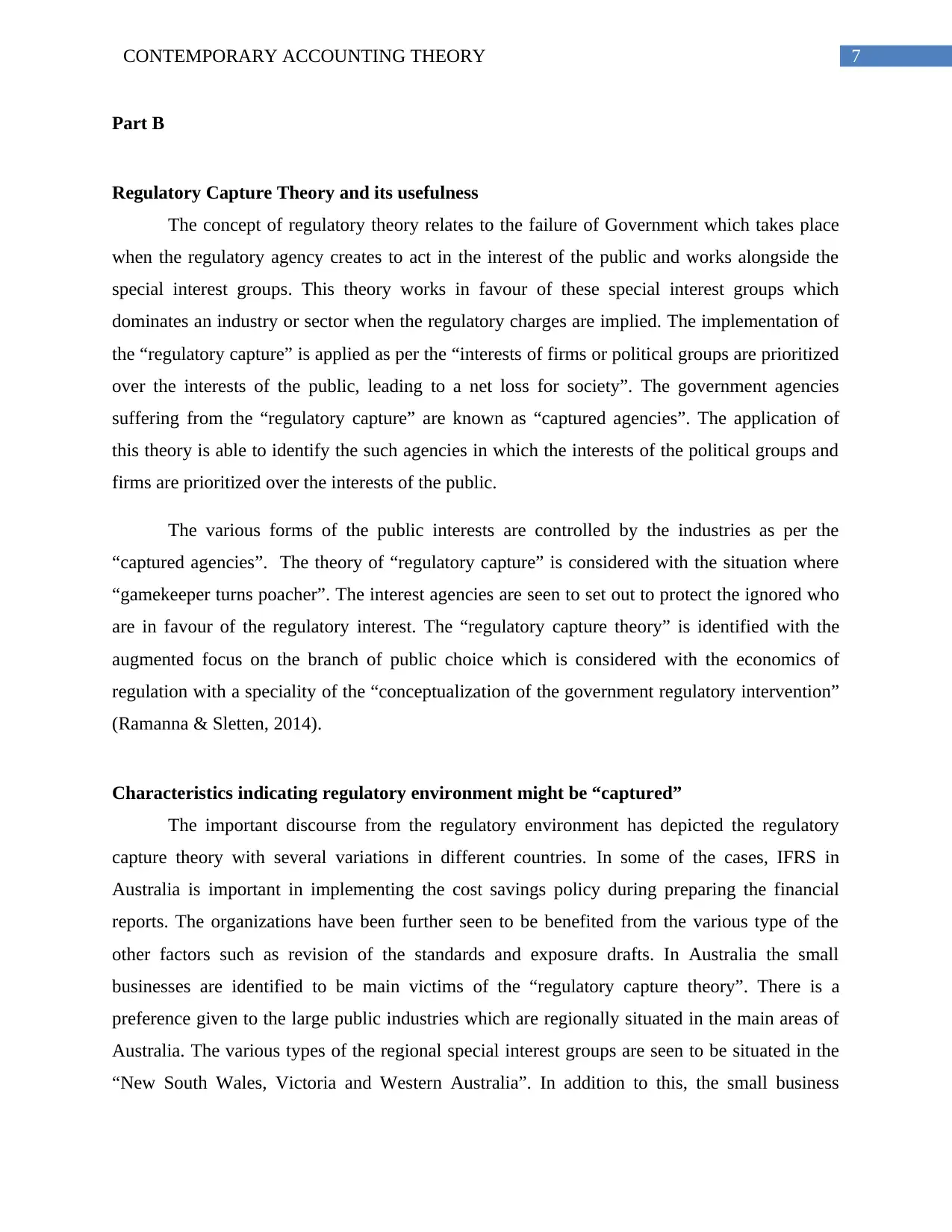
7CONTEMPORARY ACCOUNTING THEORY
Part B
Regulatory Capture Theory and its usefulness
The concept of regulatory theory relates to the failure of Government which takes place
when the regulatory agency creates to act in the interest of the public and works alongside the
special interest groups. This theory works in favour of these special interest groups which
dominates an industry or sector when the regulatory charges are implied. The implementation of
the “regulatory capture” is applied as per the “interests of firms or political groups are prioritized
over the interests of the public, leading to a net loss for society”. The government agencies
suffering from the “regulatory capture” are known as “captured agencies”. The application of
this theory is able to identify the such agencies in which the interests of the political groups and
firms are prioritized over the interests of the public.
The various forms of the public interests are controlled by the industries as per the
“captured agencies”. The theory of “regulatory capture” is considered with the situation where
“gamekeeper turns poacher”. The interest agencies are seen to set out to protect the ignored who
are in favour of the regulatory interest. The “regulatory capture theory” is identified with the
augmented focus on the branch of public choice which is considered with the economics of
regulation with a speciality of the “conceptualization of the government regulatory intervention”
(Ramanna & Sletten, 2014).
Characteristics indicating regulatory environment might be “captured”
The important discourse from the regulatory environment has depicted the regulatory
capture theory with several variations in different countries. In some of the cases, IFRS in
Australia is important in implementing the cost savings policy during preparing the financial
reports. The organizations have been further seen to be benefited from the various type of the
other factors such as revision of the standards and exposure drafts. In Australia the small
businesses are identified to be main victims of the “regulatory capture theory”. There is a
preference given to the large public industries which are regionally situated in the main areas of
Australia. The various types of the regional special interest groups are seen to be situated in the
“New South Wales, Victoria and Western Australia”. In addition to this, the small business
Part B
Regulatory Capture Theory and its usefulness
The concept of regulatory theory relates to the failure of Government which takes place
when the regulatory agency creates to act in the interest of the public and works alongside the
special interest groups. This theory works in favour of these special interest groups which
dominates an industry or sector when the regulatory charges are implied. The implementation of
the “regulatory capture” is applied as per the “interests of firms or political groups are prioritized
over the interests of the public, leading to a net loss for society”. The government agencies
suffering from the “regulatory capture” are known as “captured agencies”. The application of
this theory is able to identify the such agencies in which the interests of the political groups and
firms are prioritized over the interests of the public.
The various forms of the public interests are controlled by the industries as per the
“captured agencies”. The theory of “regulatory capture” is considered with the situation where
“gamekeeper turns poacher”. The interest agencies are seen to set out to protect the ignored who
are in favour of the regulatory interest. The “regulatory capture theory” is identified with the
augmented focus on the branch of public choice which is considered with the economics of
regulation with a speciality of the “conceptualization of the government regulatory intervention”
(Ramanna & Sletten, 2014).
Characteristics indicating regulatory environment might be “captured”
The important discourse from the regulatory environment has depicted the regulatory
capture theory with several variations in different countries. In some of the cases, IFRS in
Australia is important in implementing the cost savings policy during preparing the financial
reports. The organizations have been further seen to be benefited from the various type of the
other factors such as revision of the standards and exposure drafts. In Australia the small
businesses are identified to be main victims of the “regulatory capture theory”. There is a
preference given to the large public industries which are regionally situated in the main areas of
Australia. The various types of the regional special interest groups are seen to be situated in the
“New South Wales, Victoria and Western Australia”. In addition to this, the small business
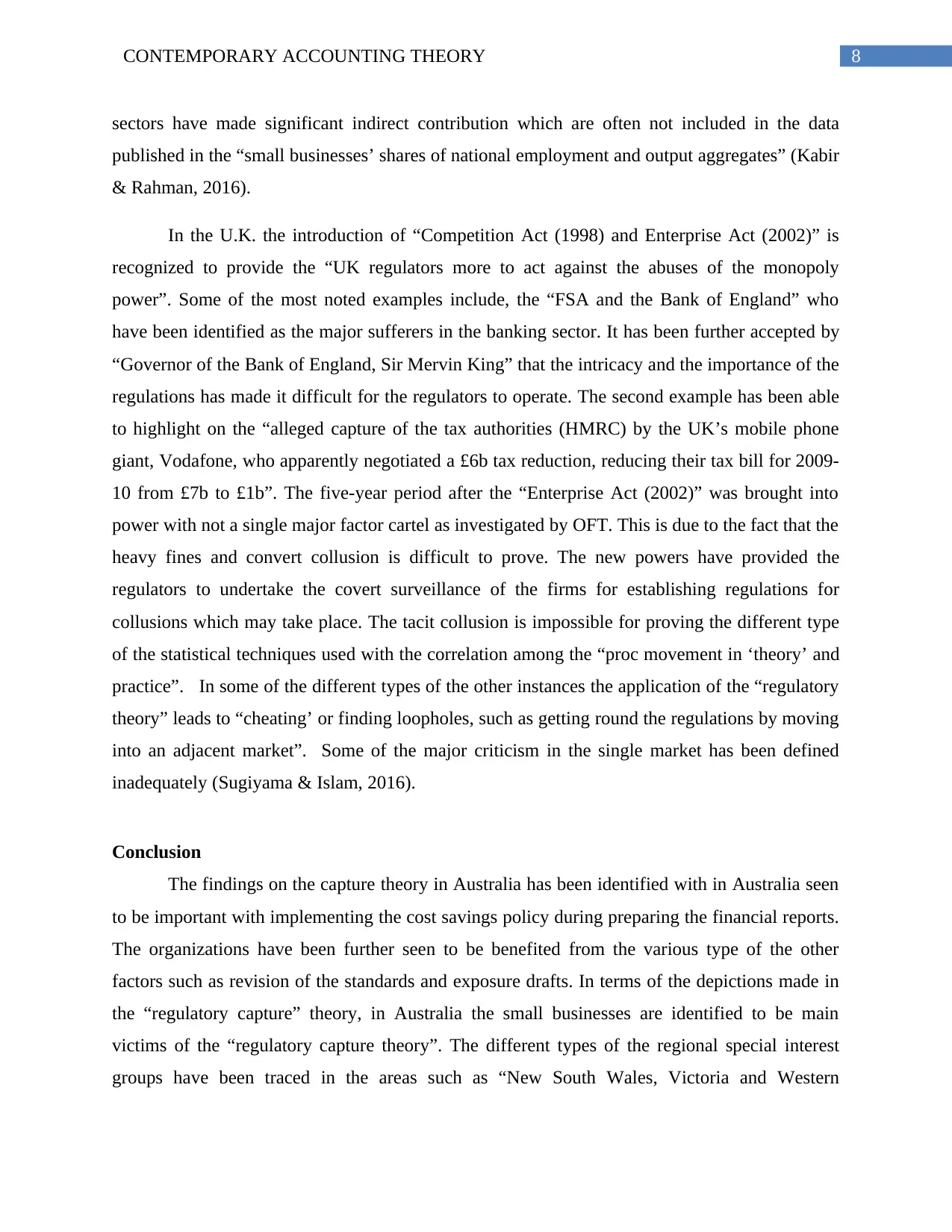
8CONTEMPORARY ACCOUNTING THEORY
sectors have made significant indirect contribution which are often not included in the data
published in the “small businesses’ shares of national employment and output aggregates” (Kabir
& Rahman, 2016).
In the U.K. the introduction of “Competition Act (1998) and Enterprise Act (2002)” is
recognized to provide the “UK regulators more to act against the abuses of the monopoly
power”. Some of the most noted examples include, the “FSA and the Bank of England” who
have been identified as the major sufferers in the banking sector. It has been further accepted by
“Governor of the Bank of England, Sir Mervin King” that the intricacy and the importance of the
regulations has made it difficult for the regulators to operate. The second example has been able
to highlight on the “alleged capture of the tax authorities (HMRC) by the UK’s mobile phone
giant, Vodafone, who apparently negotiated a £6b tax reduction, reducing their tax bill for 2009-
10 from £7b to £1b”. The five-year period after the “Enterprise Act (2002)” was brought into
power with not a single major factor cartel as investigated by OFT. This is due to the fact that the
heavy fines and convert collusion is difficult to prove. The new powers have provided the
regulators to undertake the covert surveillance of the firms for establishing regulations for
collusions which may take place. The tacit collusion is impossible for proving the different type
of the statistical techniques used with the correlation among the “proc movement in ‘theory’ and
practice”. In some of the different types of the other instances the application of the “regulatory
theory” leads to “cheating’ or finding loopholes, such as getting round the regulations by moving
into an adjacent market”. Some of the major criticism in the single market has been defined
inadequately (Sugiyama & Islam, 2016).
Conclusion
The findings on the capture theory in Australia has been identified with in Australia seen
to be important with implementing the cost savings policy during preparing the financial reports.
The organizations have been further seen to be benefited from the various type of the other
factors such as revision of the standards and exposure drafts. In terms of the depictions made in
the “regulatory capture” theory, in Australia the small businesses are identified to be main
victims of the “regulatory capture theory”. The different types of the regional special interest
groups have been traced in the areas such as “New South Wales, Victoria and Western
sectors have made significant indirect contribution which are often not included in the data
published in the “small businesses’ shares of national employment and output aggregates” (Kabir
& Rahman, 2016).
In the U.K. the introduction of “Competition Act (1998) and Enterprise Act (2002)” is
recognized to provide the “UK regulators more to act against the abuses of the monopoly
power”. Some of the most noted examples include, the “FSA and the Bank of England” who
have been identified as the major sufferers in the banking sector. It has been further accepted by
“Governor of the Bank of England, Sir Mervin King” that the intricacy and the importance of the
regulations has made it difficult for the regulators to operate. The second example has been able
to highlight on the “alleged capture of the tax authorities (HMRC) by the UK’s mobile phone
giant, Vodafone, who apparently negotiated a £6b tax reduction, reducing their tax bill for 2009-
10 from £7b to £1b”. The five-year period after the “Enterprise Act (2002)” was brought into
power with not a single major factor cartel as investigated by OFT. This is due to the fact that the
heavy fines and convert collusion is difficult to prove. The new powers have provided the
regulators to undertake the covert surveillance of the firms for establishing regulations for
collusions which may take place. The tacit collusion is impossible for proving the different type
of the statistical techniques used with the correlation among the “proc movement in ‘theory’ and
practice”. In some of the different types of the other instances the application of the “regulatory
theory” leads to “cheating’ or finding loopholes, such as getting round the regulations by moving
into an adjacent market”. Some of the major criticism in the single market has been defined
inadequately (Sugiyama & Islam, 2016).
Conclusion
The findings on the capture theory in Australia has been identified with in Australia seen
to be important with implementing the cost savings policy during preparing the financial reports.
The organizations have been further seen to be benefited from the various type of the other
factors such as revision of the standards and exposure drafts. In terms of the depictions made in
the “regulatory capture” theory, in Australia the small businesses are identified to be main
victims of the “regulatory capture theory”. The different types of the regional special interest
groups have been traced in the areas such as “New South Wales, Victoria and Western
⊘ This is a preview!⊘
Do you want full access?
Subscribe today to unlock all pages.

Trusted by 1+ million students worldwide
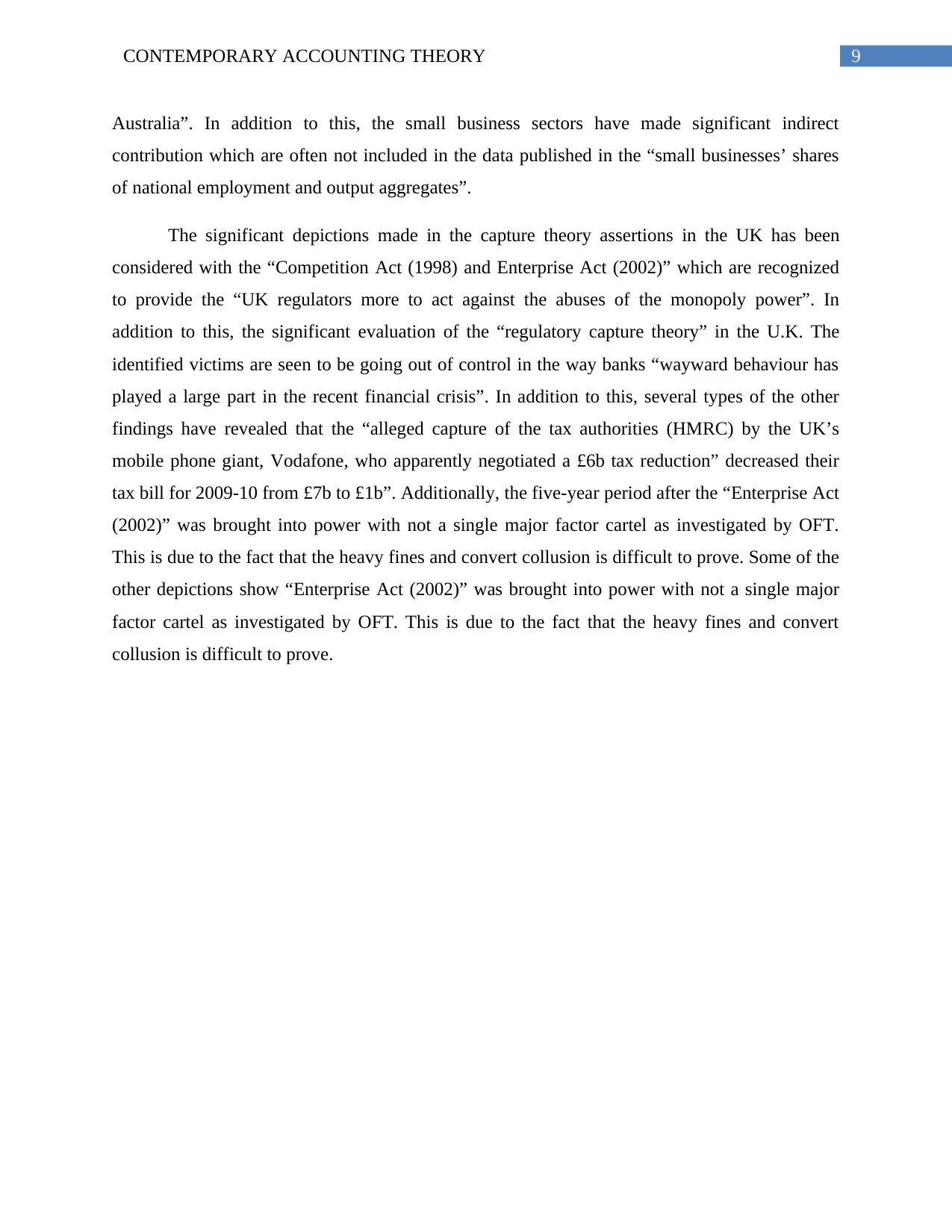
9CONTEMPORARY ACCOUNTING THEORY
Australia”. In addition to this, the small business sectors have made significant indirect
contribution which are often not included in the data published in the “small businesses’ shares
of national employment and output aggregates”.
The significant depictions made in the capture theory assertions in the UK has been
considered with the “Competition Act (1998) and Enterprise Act (2002)” which are recognized
to provide the “UK regulators more to act against the abuses of the monopoly power”. In
addition to this, the significant evaluation of the “regulatory capture theory” in the U.K. The
identified victims are seen to be going out of control in the way banks “wayward behaviour has
played a large part in the recent financial crisis”. In addition to this, several types of the other
findings have revealed that the “alleged capture of the tax authorities (HMRC) by the UK’s
mobile phone giant, Vodafone, who apparently negotiated a £6b tax reduction” decreased their
tax bill for 2009-10 from £7b to £1b”. Additionally, the five-year period after the “Enterprise Act
(2002)” was brought into power with not a single major factor cartel as investigated by OFT.
This is due to the fact that the heavy fines and convert collusion is difficult to prove. Some of the
other depictions show “Enterprise Act (2002)” was brought into power with not a single major
factor cartel as investigated by OFT. This is due to the fact that the heavy fines and convert
collusion is difficult to prove.
Australia”. In addition to this, the small business sectors have made significant indirect
contribution which are often not included in the data published in the “small businesses’ shares
of national employment and output aggregates”.
The significant depictions made in the capture theory assertions in the UK has been
considered with the “Competition Act (1998) and Enterprise Act (2002)” which are recognized
to provide the “UK regulators more to act against the abuses of the monopoly power”. In
addition to this, the significant evaluation of the “regulatory capture theory” in the U.K. The
identified victims are seen to be going out of control in the way banks “wayward behaviour has
played a large part in the recent financial crisis”. In addition to this, several types of the other
findings have revealed that the “alleged capture of the tax authorities (HMRC) by the UK’s
mobile phone giant, Vodafone, who apparently negotiated a £6b tax reduction” decreased their
tax bill for 2009-10 from £7b to £1b”. Additionally, the five-year period after the “Enterprise Act
(2002)” was brought into power with not a single major factor cartel as investigated by OFT.
This is due to the fact that the heavy fines and convert collusion is difficult to prove. Some of the
other depictions show “Enterprise Act (2002)” was brought into power with not a single major
factor cartel as investigated by OFT. This is due to the fact that the heavy fines and convert
collusion is difficult to prove.
Paraphrase This Document
Need a fresh take? Get an instant paraphrase of this document with our AI Paraphraser
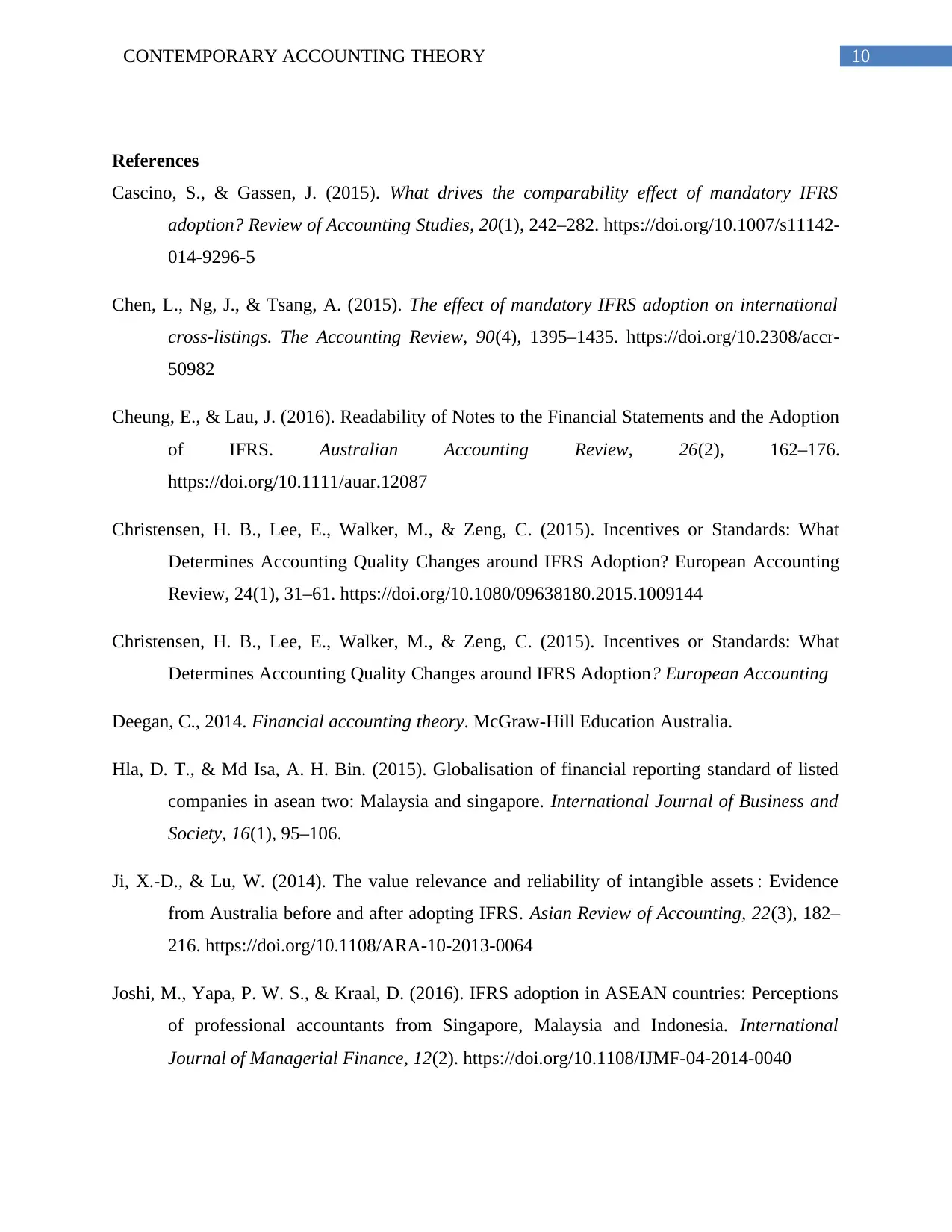
10CONTEMPORARY ACCOUNTING THEORY
References
Cascino, S., & Gassen, J. (2015). What drives the comparability effect of mandatory IFRS
adoption? Review of Accounting Studies, 20(1), 242–282. https://doi.org/10.1007/s11142-
014-9296-5
Chen, L., Ng, J., & Tsang, A. (2015). The effect of mandatory IFRS adoption on international
cross-listings. The Accounting Review, 90(4), 1395–1435. https://doi.org/10.2308/accr-
50982
Cheung, E., & Lau, J. (2016). Readability of Notes to the Financial Statements and the Adoption
of IFRS. Australian Accounting Review, 26(2), 162–176.
https://doi.org/10.1111/auar.12087
Christensen, H. B., Lee, E., Walker, M., & Zeng, C. (2015). Incentives or Standards: What
Determines Accounting Quality Changes around IFRS Adoption? European Accounting
Review, 24(1), 31–61. https://doi.org/10.1080/09638180.2015.1009144
Christensen, H. B., Lee, E., Walker, M., & Zeng, C. (2015). Incentives or Standards: What
Determines Accounting Quality Changes around IFRS Adoption? European Accounting
Deegan, C., 2014. Financial accounting theory. McGraw-Hill Education Australia.
Hla, D. T., & Md Isa, A. H. Bin. (2015). Globalisation of financial reporting standard of listed
companies in asean two: Malaysia and singapore. International Journal of Business and
Society, 16(1), 95–106.
Ji, X.-D., & Lu, W. (2014). The value relevance and reliability of intangible assets : Evidence
from Australia before and after adopting IFRS. Asian Review of Accounting, 22(3), 182–
216. https://doi.org/10.1108/ARA-10-2013-0064
Joshi, M., Yapa, P. W. S., & Kraal, D. (2016). IFRS adoption in ASEAN countries: Perceptions
of professional accountants from Singapore, Malaysia and Indonesia. International
Journal of Managerial Finance, 12(2). https://doi.org/10.1108/IJMF-04-2014-0040
References
Cascino, S., & Gassen, J. (2015). What drives the comparability effect of mandatory IFRS
adoption? Review of Accounting Studies, 20(1), 242–282. https://doi.org/10.1007/s11142-
014-9296-5
Chen, L., Ng, J., & Tsang, A. (2015). The effect of mandatory IFRS adoption on international
cross-listings. The Accounting Review, 90(4), 1395–1435. https://doi.org/10.2308/accr-
50982
Cheung, E., & Lau, J. (2016). Readability of Notes to the Financial Statements and the Adoption
of IFRS. Australian Accounting Review, 26(2), 162–176.
https://doi.org/10.1111/auar.12087
Christensen, H. B., Lee, E., Walker, M., & Zeng, C. (2015). Incentives or Standards: What
Determines Accounting Quality Changes around IFRS Adoption? European Accounting
Review, 24(1), 31–61. https://doi.org/10.1080/09638180.2015.1009144
Christensen, H. B., Lee, E., Walker, M., & Zeng, C. (2015). Incentives or Standards: What
Determines Accounting Quality Changes around IFRS Adoption? European Accounting
Deegan, C., 2014. Financial accounting theory. McGraw-Hill Education Australia.
Hla, D. T., & Md Isa, A. H. Bin. (2015). Globalisation of financial reporting standard of listed
companies in asean two: Malaysia and singapore. International Journal of Business and
Society, 16(1), 95–106.
Ji, X.-D., & Lu, W. (2014). The value relevance and reliability of intangible assets : Evidence
from Australia before and after adopting IFRS. Asian Review of Accounting, 22(3), 182–
216. https://doi.org/10.1108/ARA-10-2013-0064
Joshi, M., Yapa, P. W. S., & Kraal, D. (2016). IFRS adoption in ASEAN countries: Perceptions
of professional accountants from Singapore, Malaysia and Indonesia. International
Journal of Managerial Finance, 12(2). https://doi.org/10.1108/IJMF-04-2014-0040
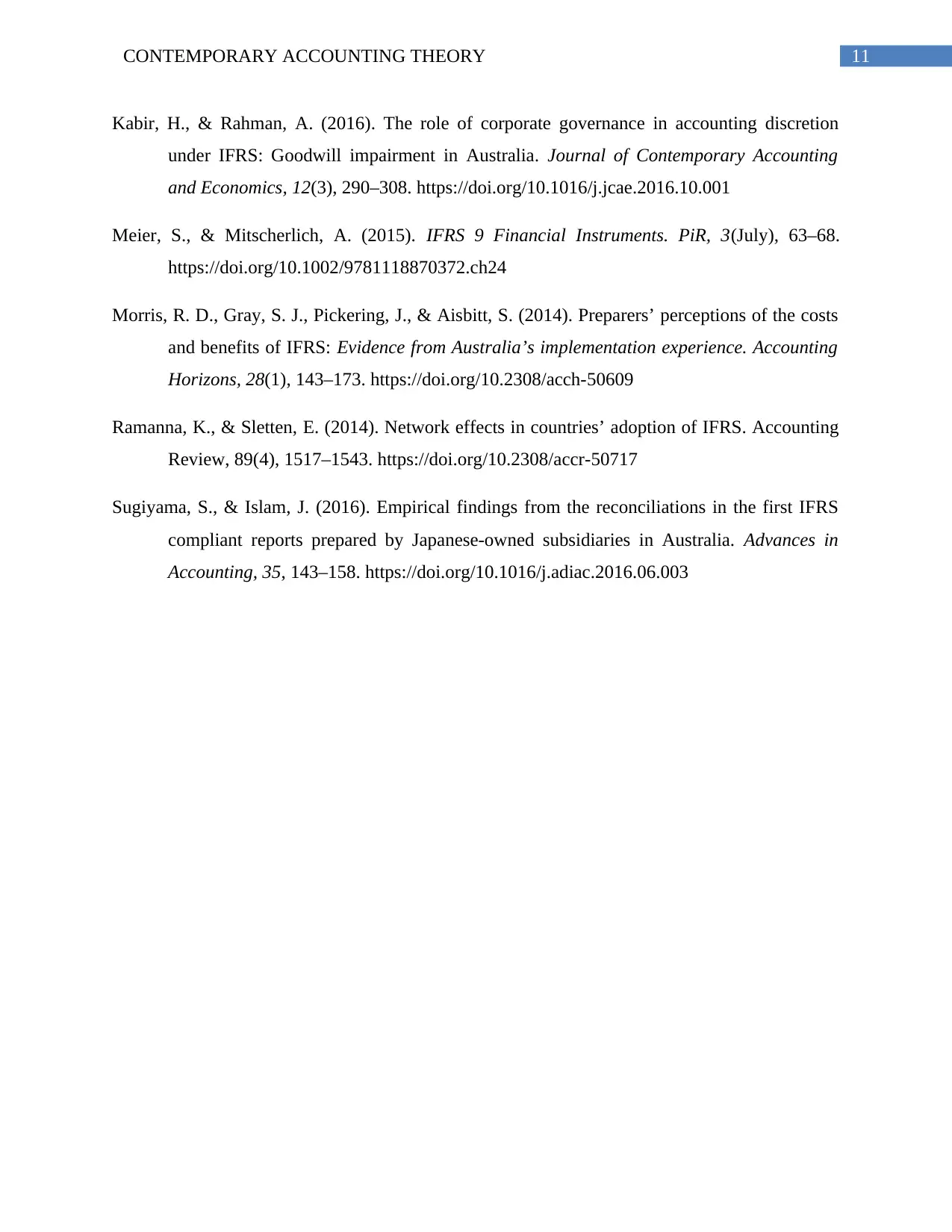
11CONTEMPORARY ACCOUNTING THEORY
Kabir, H., & Rahman, A. (2016). The role of corporate governance in accounting discretion
under IFRS: Goodwill impairment in Australia. Journal of Contemporary Accounting
and Economics, 12(3), 290–308. https://doi.org/10.1016/j.jcae.2016.10.001
Meier, S., & Mitscherlich, A. (2015). IFRS 9 Financial Instruments. PiR, 3(July), 63–68.
https://doi.org/10.1002/9781118870372.ch24
Morris, R. D., Gray, S. J., Pickering, J., & Aisbitt, S. (2014). Preparers’ perceptions of the costs
and benefits of IFRS: Evidence from Australia’s implementation experience. Accounting
Horizons, 28(1), 143–173. https://doi.org/10.2308/acch-50609
Ramanna, K., & Sletten, E. (2014). Network effects in countries’ adoption of IFRS. Accounting
Review, 89(4), 1517–1543. https://doi.org/10.2308/accr-50717
Sugiyama, S., & Islam, J. (2016). Empirical findings from the reconciliations in the first IFRS
compliant reports prepared by Japanese-owned subsidiaries in Australia. Advances in
Accounting, 35, 143–158. https://doi.org/10.1016/j.adiac.2016.06.003
Kabir, H., & Rahman, A. (2016). The role of corporate governance in accounting discretion
under IFRS: Goodwill impairment in Australia. Journal of Contemporary Accounting
and Economics, 12(3), 290–308. https://doi.org/10.1016/j.jcae.2016.10.001
Meier, S., & Mitscherlich, A. (2015). IFRS 9 Financial Instruments. PiR, 3(July), 63–68.
https://doi.org/10.1002/9781118870372.ch24
Morris, R. D., Gray, S. J., Pickering, J., & Aisbitt, S. (2014). Preparers’ perceptions of the costs
and benefits of IFRS: Evidence from Australia’s implementation experience. Accounting
Horizons, 28(1), 143–173. https://doi.org/10.2308/acch-50609
Ramanna, K., & Sletten, E. (2014). Network effects in countries’ adoption of IFRS. Accounting
Review, 89(4), 1517–1543. https://doi.org/10.2308/accr-50717
Sugiyama, S., & Islam, J. (2016). Empirical findings from the reconciliations in the first IFRS
compliant reports prepared by Japanese-owned subsidiaries in Australia. Advances in
Accounting, 35, 143–158. https://doi.org/10.1016/j.adiac.2016.06.003
⊘ This is a preview!⊘
Do you want full access?
Subscribe today to unlock all pages.

Trusted by 1+ million students worldwide
1 out of 12
Related Documents
Your All-in-One AI-Powered Toolkit for Academic Success.
+13062052269
info@desklib.com
Available 24*7 on WhatsApp / Email
![[object Object]](/_next/static/media/star-bottom.7253800d.svg)
Unlock your academic potential
Copyright © 2020–2025 A2Z Services. All Rights Reserved. Developed and managed by ZUCOL.




